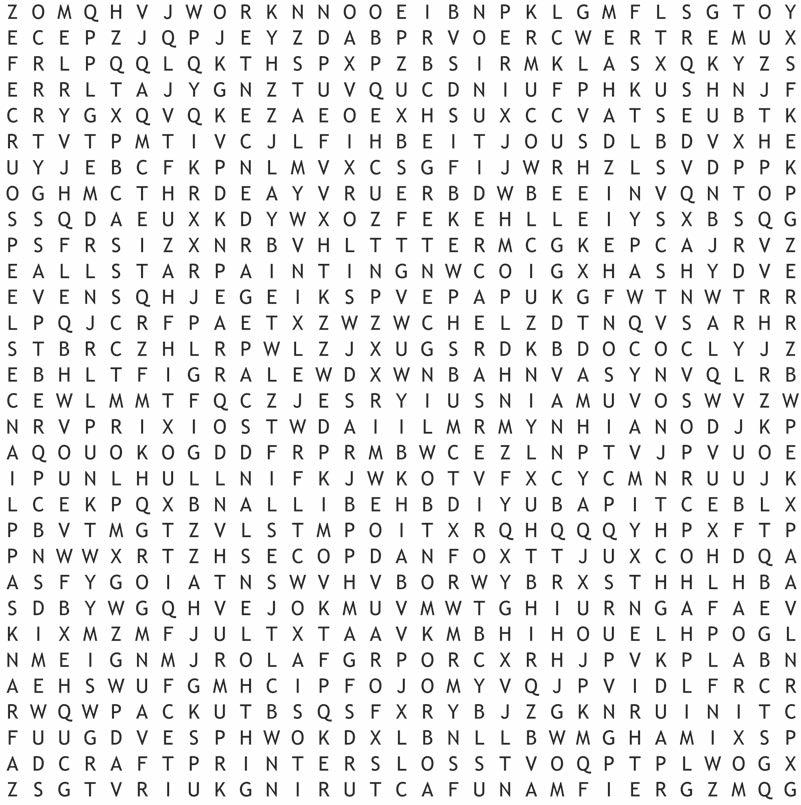







Saturday, April 19, 2025

To those unfamiliar with lawn maintenance, the term “scarify” might sound like something horror movie directors hope to do to audiences who watch their films. But scarifying has nothing to do with frightening filmgoers, and everything to do with promoting a lush, green and healthy lawn.
WHAT DOES IT MEAN TO SCARIFY A LAWN?
Scarifying a lawn involves the utilization of a scarifier to remove dead organic matter that can build up on a lawn over time. When such thatch develops and settles in on a lawn, it can hinder growth by blocking water and nutrients from reaching the soil. Scarifying with a scarifier, or a rake in a smaller lawn or one where thatch buildup is not significant, can help to ensure a lawn can benefit from water and nutrients, such as those which are often found in fertilizers.
IS A SCARIFIER NECESSARY?
Lawn and garden tools make yard work easier, and a scarifier is no exception. Scarifiers range in price, but many effective machines are relatively inexpensive when compared to more costly machines like lawn mowers and aerators. While a scarifier certainly can make dethatching easier, some homeowners might be able to get by with a spring-tined rake. However, it’s less labor-intensive to forgo a rake and use a scarifier on larger properties.
ARE THERE ADDITIONAL REASONS TO SCARIFY?
Thatch buildup also can promote the growth of moss, so scarifying can decrease the chances that healthy grass is pushed to the side by sponge-like moss that can quickly overtake a property.
IS THERE ANYTHING I SHOULD KNOW ABOUT SCARIFYING?
A lawn that has never before been scarified is likely to produce a substantial amount of thatch, which can be made up of old grass clippings, leaves and moss. Though many scarifiers come with attachable buckets that collect the thatch, such baskets
tend to be rather small and fill up quickly, forcing frequent stopping that can add a considerable amount of time to the job. If possible, homeowners with lawns that have significant thatch buildup might want to scarify without the bucket attached. Doing so will leave lots of piles of dead organic matter strewn about the yard, but the job is likely to go more quickly if those heaps are gathered up with a rake after scarifying and then discarded. Constant stopping to empty a small bucket filled with thatch will compromise efficiency and that can be frustrating.
Homeowners also should not expect their lawns to stun after a scarifying session. The lawn will likely look worse, but that’s only temporary. Once the dethatched lawn gets some water and fertilizer, the soil beneath will be more ready to receive them, and the lawn will soon look much better.
Homeowners are urged to do their homework and read product reviews before choosing a scarifier. The majority of scarifiers now on the market are electric, so homeowners will need the ability to plug into a power source when using such products. They also will need to negotiate around the cord, which should be a lengthy extension designed for outdoor use. Homeowners with particularly large properties may want to purchase a gas-powered scarifier, but such products are harder to come by than their electric counterparts, and could be considerably more expensive as well.
Various lawn professionals recommend scarifying a lawn at least once per year, and springtime is a popular season to do so. Scarify prior to an initial fertilizer application so that does not block the lawn from getting the nutrients in the fertilizer. A second scarifying session may be necessary in fall.
Scarifying can be an important step in creating a stunning and healthy lawn.
TF254781

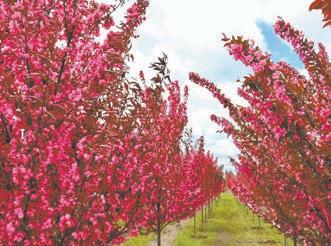


Regular maintenance is necessary when caring for a lawn, and various strategies translate into thicker, greener and healthier grass. Much like car owners routinely get an oil change or tire rotation on their vehicles, homeowners should recognize that certain lawn care strategies are periodically necessary to keep a property looking its best. Aeration is one task that can complement other lawn care strategies throughout the growing season.
The Home Depot says that aeration involves making holes in the lawn to loosen the soil underneath. Over time, the lawn and soil can become compacted, creating a layer of thatch that forms between the soil and the grass in the lawn. Thatch can prevent air, water and fertilizer from reaching the roots of the grass, eventually stifling growth. The holes made during aeration allow oxygen, water and nutrients to reach the lawn’s roots.
Homeowners can use different aeration equipment, including manual and
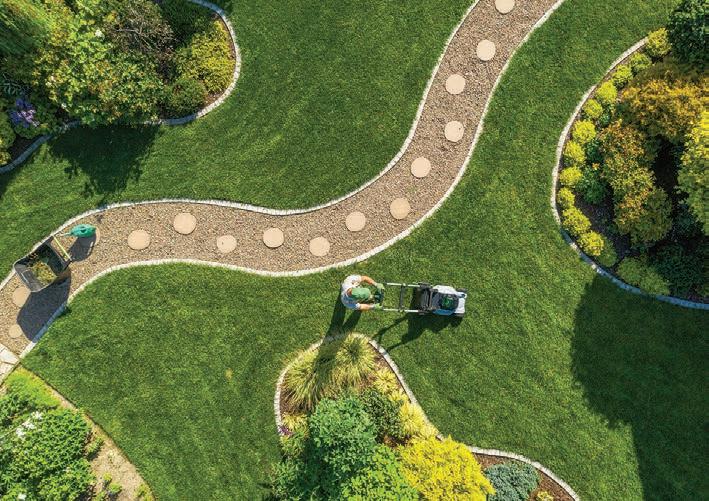
automated machinery. Some homeowners wear spiked aerator “sandals” strapped to shoes to walk across the lawn. These may be useful on a small scale, but not on larger properties.
Slicing aerators have rotating blades that slice through grass and thatch into the soil. Core or plug aerators often are preferential for lawn professionals. Hollow tines remove plugs of soil from the
lawn and deposit them on top where they break down.
Aeration can be good for a lawn, but it can cause stress to the grass if timed improperly, advise the lawn care experts at Pennington. Cool-season grasses common in northern lawns should be aerated in the early fall or early spring. Warm-season grasses should be aerated in the late spring or very early summer. Aeration should be done right before the grass reaches peak time for natural growth.
According to The Spruce, it is necessary to water the grass every two to three days after a lawn has been aerated. This also is the time to perform overseeding. Apply a quality, slow-release fertilizer to revitalize the lawn. Wait at least a month before mowing, and avoid heavy traffic on the lawn after aerating to prevent grass damage. Aeration is an important step to maintain lawn health. While aerating can be labor-intensive, the end result of a lush lawn can be worth the extra effort. TF254803
plus 100’s of items in-stock and ready for immediate delivery.
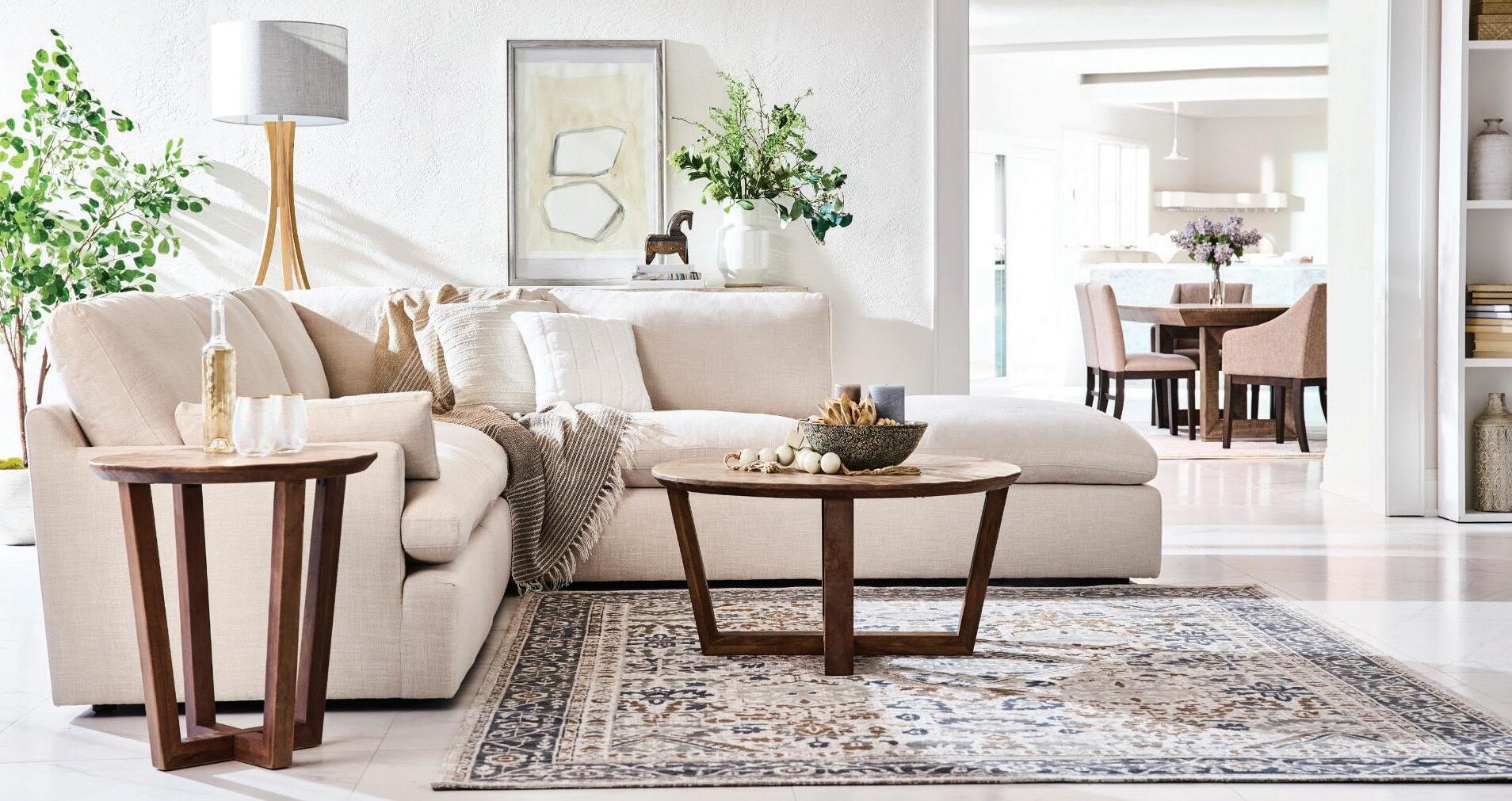

Gardening is a popular hobby all over the world. Ruby Home Luxury Real Estate estimates there are 71.5 million gardening households in the United States alone. That translates to around 185.9 million people engaged in some form of gardening, which places the U.S. among other countries where gardening is wildly popular, including Australia and China.
A greater number of people are showing interest in gardening, which is a rewarding hobby that’s good for the mind and the body. Those who are new to gardening may need a crash course to get started. These pointers can help anyone foster a newfound passion for gardening.
Spend time in the yard and decide where to house a garden. A far-off corner may get the most sun, but will you forget about the garden if it is too far away? Ideally, the garden should be located where it will get at least six to eight hours of sun each day. There also should be a water source nearby. The spot also should be convenient so that it is easy to go and pick vegetables or prune flowers.
If you’re new to gardening, begin with a small garden footprint so that you can get your feet wet. A raised garden bed can be a good starting point because it is contained and easy to maintain. As your experience (and garden) grows, you can add to the garden size the next time around.
It’s possible but unlikely that the soil in the backyard is the perfect mix to


grow healthy plants. It’s more likely that the garden will need some soil modification. You can test the soil makeup with do-it-yourself kits or work with a garden center. A garden typically requires a mix of compost to add nutrients to the dirt; peat moss or coconut coir to help with water retention and to make the soil lighter; and vermiculite that helps to retain water. A compost bin set up at the same time as the garden allows gardeners to continually produce nutrient-rich food to add to the garden.
It’s best to keep a few things in mind
when planning the garden. Think about what will grow well in your climate. Consider how big the garden will be and the size of mature plants. A small garden will not be able to accommodate corn, for example. Also, how would you like the space to look and what will be its function? Is this a purely aesthetic garden or one that will be food-bearing?
If you’ll be starting a garden from seeds, it’s best to start indoors before your region’s frost-free date. This way the delicate plants will get the needed care and can establish before they go
outdoors in the ground. Keep them humid by covering the seedlings in plastic wrap. You can start the seeds in different containers, even empty egg cartons. Transplant to larger containers after the seedlings grow a second set of leaves. Once you’re free from overnight frost, you can place the established, strong seedlings in the ground.
An automatic watering system, such as a timer hooked up to the sprinkler, can keep the garden well watered, which increases the chances of success. Then it will only be a matter of weeks before the garden can be enjoyed throughout the season.
TF254802



































































































(BPT) - Americans are spending more time in their outdoor spaces - and want to maximize those spaces. Studies show that nearly 90% of homeowners consider their outdoor areas to be important to their health and well-being. Design trends reflect that people are showing more interest in connecting with nature in their own backyard and enjoying the comforts of indoor living while gathering outdoors. This means creating environments that are comfortable, multifunctional and cost-effective.
The outdoor design experts at Belgard®, the trusted leader in hardscape solutions from pavers to retaining walls, share exclusive insights into 2025 outdoor design trends to help homeowners plan their dream outdoor spaces.
As property footprints continue to shrink year over year, homeowners are looking for aesthetically pleasing ways to incorporate more privacy from neighbors or their surroundings. Decorative screen panels, pergolas, built-in planters and other structures can add elements of both beauty and functionality that provide a sense of solitude, even in urban environments.
Sound gardens and water features can further enhance a feeling of solitude by adding audible privacy from neighbors or street traffic. For example, even a simple fountain or water bowl can enhance the ambiance and help muffle sound.
While minimalism remains a popular trend, there’s also been a shift back to a more classic style in indoor and outdoor home design. Mixed materials and warm colors such as beige and sepia are re-emerging, which lend themselves to a more traditional aesthetic.
With modular options from Belgard, a mix of different materials with multiple textures and sizes can create limitless possibilities while keeping with a classic design aesthetic. Because they’re available in many styles, shapes, and sizes designed to work together, a variety of paver patterns can be combined seamlessly to achieve any desired overall look.
As outdoor spaces are now a musthave for homeowners, they must be convenient to access and offer the same
amenities as the home’s indoor spaces. Homeowners are looking for their outdoor space to transition easily from the house to the built environment while offering the same modern conveniences of lighting, eating, Wi-Fi, quality furnishing and accessories.
Using outdoor spaces to improve your well-being is a top focus for many people today. Americans are looking to be more balanced and in harmony with their environment, favoring the use of native plants and sustainable materials like permeable pavers, which promote better water drainage and reduce environmental impact.
Gardening is also a popular hobby that helps improve people’s feeling of well-being, so enthusiasts can opt for raised garden beds or planters to pur-

sue their growing goals in their outdoor spaces. For example, Belgard offers options to create built-in planters as part of your overall hardscape design with its Belgard Artforms modular outdoor panel system. You can use the panels, which are sized in modular shapes, to quickly and efficiently construct planters, seating, outdoor kitchens, fire features and more.
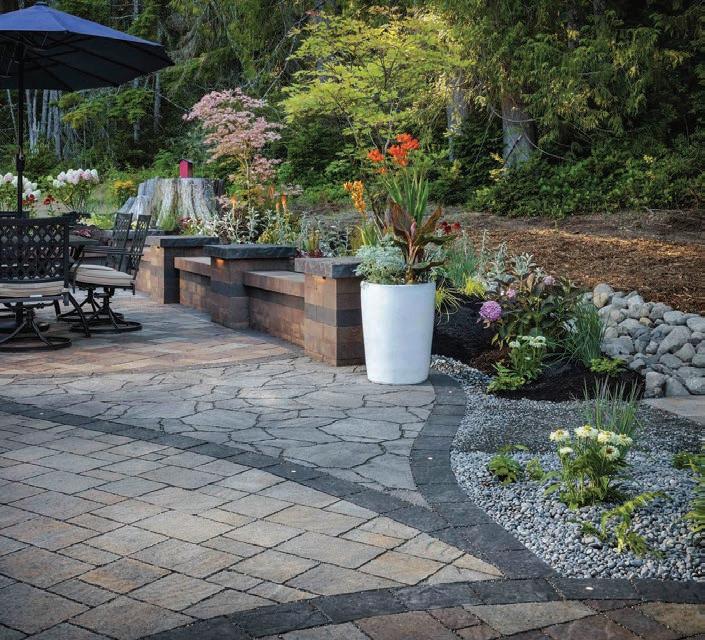




ers want to maximize small spaces through modular components that serve multiple purposes, like built-in seat walls, fire features, water features and planters that seamlessly blend into a living space - offering both functionality and visual appeal.
Homeowners can get creative with outdoor spaces with the right hardscape materials. For example, a small space can be transformed into a lush oasis by adding a vertical garden, or underutilized spaces like side or front yards can become cozy sitting areas. Even a small patio can serve as an al fresco dining space, and it doesn’t take a lot to add an outdoor workstation with the right tools and tech. Patio pavers and wall units help define spaces, making them serve more than one purpose for any household.
By designing outdoor environments that support their health and wellness, individuals can cultivate spaces that provide a retreat in their own backyard to improve their quality of life.
In every metro area, property sizes are smaller than ever. With this shift plus budget considerations, homeown-
These strategic investments not only increase the functionality and enjoyment of outdoor areas but also significantly boost curb appeal and the home’s property value, making them a smart choice for homeowners looking to maximize their limited spaces.
To find inspiration for any outdoor space, visit Belgard.com.
(BPT) - Exterior wood requires regular upkeep to prevent weather damage and preserve its longevity. Coming off a long winter of snow and rain, it’s important that homeowners tend to their decks and outdoor furniture to maximize the lifespan of their wood.
Spring marks the ideal time for homeowners to prepare their outdoor spaces for the warmer months ahead. With BBQs, summer holidays and dinner parties just around the corner, homeowners are looking to level up their exteriors with a new stain.
“In addition to its functionality, wood stain can noticeably transform an outdoor space,” said Ashley McCollum, color expert. “Whether you’re updating your deck, furniture or fence, a new finish can significantly enhance your curb appeal.”
Before embarking on a stain project, it’s important to select the color and level of transparency that will achieve the desired finish, specific to each wood type.
According to the color experts for popular woodcare brands Olympic Stains, Pittsburgh Paints & Stains and Flood wood finishes, this year, homeowners are searching for fail-proof stain colors that empower them to design their spaces with ease. While modest blacks and subtle white oaks previously dominated the color space, homeowners appear more drawn toward warmer stains that complement their modern, minimalist eras while adding depth and character to their spaces.
“There’s been a notable shift over the years from light, muted colors toward richer, deeper hues that exude warmth and comfort,” said McCollum. “Like in their homes, people are trying to add bolder colors to personalize their spaces.”
A popular choice that is most known for transcending design styles, Oxford Brown, was revealed as the top trending stain color for 2025. As a warm, earthy hue that evokes a rustic vintage charm, Oxford Brown is ideal for wood that has lost its luster over time. Its de-
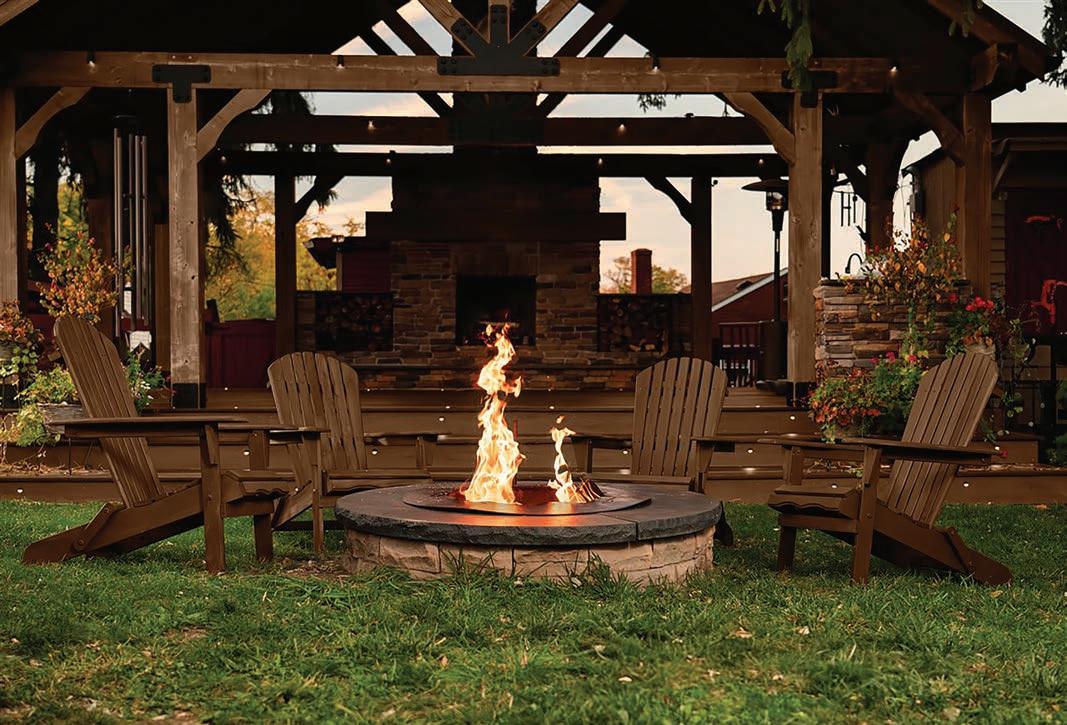
sign versatility makes it well suited for exterior spaces that are both future-inspired and classic designs.
“Oxford Brown can adapt to both a modern, rustic look or an aged, historic style,” said McCollum. “Its timeless and adaptable properties harmonize with all environments, making it a truly versatile choice for anyone looking to level up their exterior.”
After selecting a color, there is an option of transparency type. Oxford Brown is available as a semi-transparent and solid stain, so homeowners and DIYers can select the option best suited for their project.
For a rich finish that enhances the wood grain, woodcare experts recommend Oxford Brown in a semi-transparent stain and sealant, such as
Olympic Maximum, Pittsburgh Paints & Stains Paramount or Flood Wood Finishes Pro. For a deeper, alternative look better suited for weathered wood, homeowners can opt for Oxford Brown in a solid ready-mix stain.
Homeowners and DIYers can consider updating their outdoor spaces with one of the following stain projects:
• Beautify your deck and furniture. Choosing the right stain color and transparency can enhance the natural beauty of the wood. A semi-transparent stain adds a subtle color and enriches the deck’s natural grain, while a solid stain provides maximum protection to aging wood surfaces.
• Protect your pergola against the elements. While rain can warp and crack wood, leaving residues of mold and
mildew, the harsh sun can be just as damaging for your pergola. Intense heat can dry and discolor the wood, causing it to split and turn gray. It’s recommended to stain and seal your pergola every one to three years to protect it against these harsh conditions and preserve its natural beauty.
• Revive your fence from years of weathering. Fences can easily detract from a house if the wood looks faded and unkept. A semi-transparent or solid stain can add major curb appeal, reviving wood that has lost its luster over time in three steps (See www.olympic. com/advice/how-to-stain-a-fence).
This year’s stain color of choice for homeowners and DIYers, Oxford Brown, is available at The Home Depot, Menards, PPG Paints stores and independent retailers.



































































• Brookmont Bowling Center
• Tholens’ Landscape & Garden Center
• Greif Manufacturing
• Ryan’s Pier
• Two Rivers Area Credit Union





















































Ten lucky winners will be randomly drawn from all correct contest entries. Each will receive one flat of flowers from Tholens’ Landscape & Garden Center!
Find the 10 business names below in the puzzle, then enter for a chance to win!
• AllStar Painting
• Adcraft Printers
• Frank’s Appliance & SleepSource
• Benoit Greenhouses
• Thrivent
Do you subscribe to the Daily Journal? o Yes o No
COMPLETE, CLIP OUT AND MAIL OR DROP OFF YOUR ENTRY TO: Daily Journal, 1 Dearborn Square, Suite 200, Kankakee, IL 60901
Deadline to enter is 4 pm, Friday, May 2, 2025 Winners will be published in the Daily Journal May 7.





























































Courtesy of Tholens’ Landscape & Garden Center, 1401 N. Convent, Bourbonnais


















































